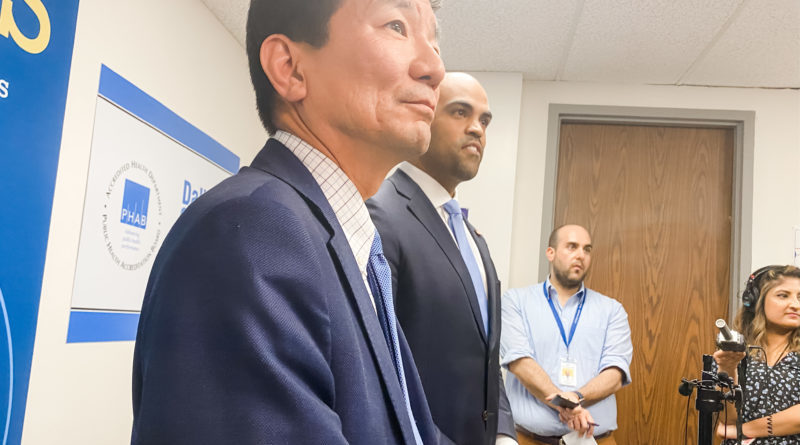Sheltered Diaries: The Smartest Man in Dallas County
As I’ve mentioned before – the 9-year-old that lives in our house has, by default, become quite the little expert in COVID-19.
It can’t be helped when your father works to help a hospital communicate about it, and when your mom is reporting on it. He now can tell you why masks are important, the best things to do when you come back from the grocery store, and whether or not you need to quarantine your mail.
And he also knows the major players, and has watched many a press conference with me. It’s the STEM education nobody thought we’d be teaching, but here we are.
So suffice to say, when I told him yesterday that I needed him to be quiet while I had a quick phone interview, he was full of questions.
Tiny: “Who are you talking to now? The governor? Batman? Some rando?”
Me: “Uh, no. I’m going to talk to Dr. Huang with the county health department …”
Tiny: “DOCTOR PHILIP HUANG? THE DOCTOR PHILIP HUANG?”
Me: “Um, yes?”
Tiny: “OH MY GOD BURY THE LEDE MOM. He’s only the smartest man in Dallas County.”
Me: “He is definitely responsible for a lot of things right now, that’s for sure.”
Tiny sighs.
Tiny: “No Mom. He’s smart. Really smart and he knows a lot about this virus. Do not embarrass yourself with the smartest man in Dallas County, OK? He may even be the smartest man in all of Texas. Oh man, you’re really going to embarrass me, I know it.”
I was not prepared for the amount of fanboy my child brought to the table, but I hope you come away from the following conversation with Dr. Philip Huang, director of Dallas County Health and Human Services, feeling a little smarter – after all, it’s a conversation with, apparently, the smartest man in Dallas County.
My original reason for talking to Dr. Huang was, by the way, to better understand some questions and comments our readers have made on our Facebook pages.
PN: We get a lot of comments about the survival rate of this virus – namely, people repeating that figure that 98% survive it. And we’ve shared some information about what that statistic actually means, but could you explain what that means when someone points that out – what they’re actually saying?
Huang: “Well, I mean, you’re talking about a 2% mortality rate, which means for every hundred people, two people are going to die – which is pretty horrific.”
PN: And those other 98 who do get it – it’s no picnic for them either, right?
Huang: “Right. And while still, a majority may have mild symptoms, again, 2% dying is a very high – that’s two people dying for every hundred persons. That’s pretty bad.”
PN: We hear a lot of discussions about which number we should be paying attention to – is it the number of new cases? Is it the number of hospitalizations? Is it the number of coronavirus cases versus the number of influenza cases? What numbers are important in understanding where we stand?
Huang: “It’s no one specific number, but it’s more trends. If we see 14-day trends in some of those numbers, that’s when we will know if it’s going down, and that would be good. And if things are going up – that’s not a good thing.”
PN: How concerned are you with this UT Southwestern research that’s indicating that we could have a massive resurgence this summer?
Huang: “That’s obviously very concerning. It would mean a lot of deaths, a lot of severe illness, and potentially really causing a lot of turmoil in our healthcare system.”
PN: Has anything surprised you about the public response to the pandemic?
Huang: “I don’t really think this came as a surprise to me, but I do think the public responded well to shelter-in-place, and it worked.”
PN: Early on, I saw someone point out that if this shelter-in-place measure worked and flattened the curve, there would be one group that would say, “Oh, wow, this totally worked,” and another that would say, “Everyone overreacted.”
Huang: “If we were successful, people are going to say, ‘Oh, it wasn’t that bad after all,’ and if it’s not, it’s ‘Oh, you really screwed up.'”
PN: What are you and your family doing to be safe? What’s your comfort level with going out in public spaces right now?
Huang: “You know those guide documents with the red, orange, yellow, and green? That. I think that’s what the experts have recommended as the appropriate sort of level of activity and response right now.”
PN: What do you find yourself missing?
Huang: “I am missing going to restaurants, going to events, going to a lot of stuff. I mean, I miss that. I miss that a lot.”
PN: One thing that people have mentioned is that they’ve been surprised about what they don’t miss, and that they’ve found – and I hate to use the term silver lining – but they’ve found that some of the things they’ve discovered during the shelter-in-place are things they hope stick around – like the closeness of family, and such. Have you found that to be the case?
Huang: “I think a lot of people have found they’ve been slowing things down a bit. I think that people have spent a lot more time cooking and not just going out all the time, but spending time at home with their families and things like that, which is nice.”










You lost me at 2% mortality rate. Quit reading after that. That’s ridiculous and you all know it…..